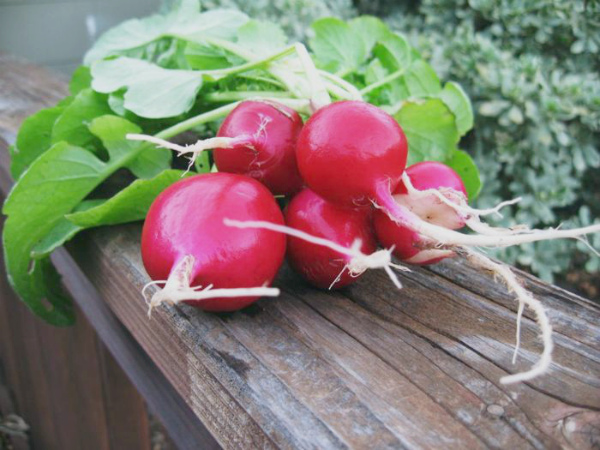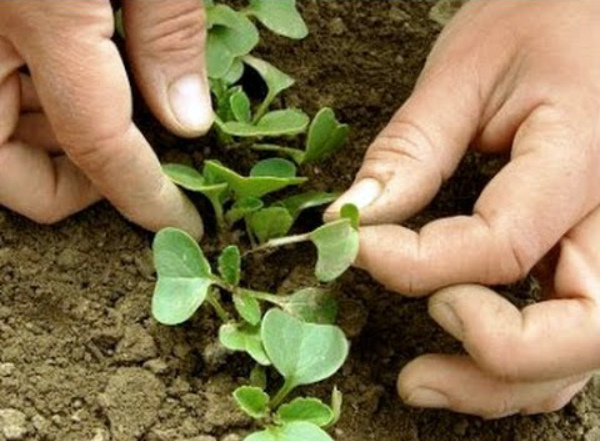Rules for planting radishes in open ground
Content
Description of the vegetable
We cultivate the annual Cabbage (Cruciferous) radish in our gardens for the root vegetable, which is actually a modified shortened stem. A rosette of leaves is formed above it, and a taproot with a small number of lateral roots grows from below. Leaves can be of different shades of green, from dark green to very light yellowish green. The root of most cultivated varieties grows from 15 to 30 cm.
Until the desired maturity of the root crop takes from 20 to 40 days after sowing, depending on the variety and care. This is the time when it acquires the greatest gustatory value and concentration of nutrients. The root crop can have different shapes and colors - it can be red, white, yellow, purple, round or flattened ball, long cylinder or spindle. It can be small, weighing only 15–20 g, medium - up to 50 g, large - up to 200 g. The Japanese love to grow giant radishes, which their breeders have worked on thoroughly.
If you do not dig up the root crop, then the plant develops further - forms a stem, peduncles, flowers, fruits. From the moment of sowing to ripening of the fruit, it takes from 150 to 170 days. Flowers are white, pink, even purple, they are collected in a cluster inflorescence. Radish is a cross-pollinated plant. In order to preserve the properties of the variety, it is impossible to allow the growth of other varieties or related plants (especially radish) at a distance of 200 m.
Flowering lasts a month, when it ends, the fruit is formed - a dry pod, the seeds ripen 65 or 70 days after flowering. Radish seeds are small brown, round or flat-round, they remain viable for 5-6 years. When buying seeds, you should pay attention to their color - from old age, the brown color gives way to gray. 1 g of seeds contains up to 130 seeds.
In the industrial production of seeds, plants are simply allowed to grow and develop without changing care, and in summer cottages, gardeners accelerate this process by transplanting the mother plant (mother plant) to another place. When it is planted in a new place, the care is changed (for example, the watering schedule), then the plant from the received stress rather throws out an arrow. This is facilitated by the high temperature and increased daylight hours.
Landing dates
Planting radishes in open ground occurs earlier than other vegetables due to its ability not to suffer from the cold and even easily endure night frosts. This vegetable will not be hindered by night -6 degrees, the main thing is that the temperature rises above +10 degrees during the day, so that shoots appear sooner. If the temperature rises to +15 degrees, then the shoots should be expected in a week, when the heat is set in the region of +20, then the sprouts appear on the 4th or 5th day.
Usually, radishes are sown in late March or early April, when the sun is already warming up.To speed up the germination process, crops can be covered with foil or agrofibre. The root crop grows best at an air temperature of +20 degrees. When it gets hotter, daylight hours lengthen, the plants rush to shoot, which is why radishes are grown in spring and autumn.
If we consider that the harvest is removed after 16–20 days for the early varieties or after 40 days for the latest varieties from the moment of sowing, then we can calculate the time when it is better to plant the radish so that it ripens before the heat.
Seeds can be sown in a few days so that the crop ripens almost constantly, but not simultaneously, since radishes, especially early ones, cannot be stored for longer than several days without losing their taste and useful properties.
They usually take a break for the summer, and then they start sowing radishes again at the end of August or September. Those who want to eat a fresh vitamin vegetable all summer, plant it, and then cover the plantings with an opaque 18-oo covering material daily to reduce daylight hours.
The most daring gardeners sow radishes before winter. Sowing occurs when the garden is already ready for winter, before the first frosts, sometimes even after the first snow. Sowing under winter will allow you to get a harvest earlier than the earliest variety planted in spring ripens.
Preparing for landing
The place for radishes on the site needs to be thought out and prepared in advance, preferably in the fall. It cannot be planted where its relatives from the Cabbage family used to grow, it will grow best after potatoes, onions, and garlic. You can plant this early vegetable among others, later ones, for example, tomatoes, cucumbers. Although it often happens that the radish is sown early, then the harvest is harvested, and seedlings of tomatoes, peppers, eggplants are planted in its place.
The garden bed is prepared in an open flat place, preferably protected from the wind. Radish loves fertile light, non-acidic soil. Since autumn, the site needs to be thoroughly dug to a depth of 30 cm, compost or humus should be added, if you need to deoxidize the soil, then lime. From mineral fertilizers, radish responds well to superphosphate, ammonium nitrate, potassium chloride. The structure of heavy clay soil must be changed by the introduction of river sand or peat.
Seeds can be sown unprepared, but in order to increase germination and shorten germination time, they are calibrated by sifting through a sieve with cells of 2-3 mm, and then soaked in warm water or simply left in a damp cloth overnight. Large seeds will sprout well and with proper care they will grow large roots, so when choosing seeds, preference should be given to large ones with a brown color. The gray color of the seeds indicates their long storage and warns of poor germination. It is also advisable to disinfect the seeds by soaking them for 30 minutes with a bright solution of potassium permanganate. All these manipulations should speed up the harvesting process and exclude plant diseases.
For winter sowing, the garden bed is prepared in the summer, even the grooves are marked, and then they cover it with a film, pressing it along the edges so that it does not fly away with the wind.
Landing technology
Plant radishes in rows or nests. 10 cm is left between the rows, and from 3 to 5 cm between the seeds in a row, this depends on the expected size of the root crop. If you plant it in a nesting way, then at least 5 cm of free space should remain between the plants on all sides. If the plants are planted in rows, and a path is left every 1 m, then it will be easier to care for them.
The planting material is placed in a groove or hole, having previously watered them with hot water, and then covered and tamped wet soil so that the depth is no more than 1.5 cm. It is necessary to tamp in order to achieve maximum adherence of the soil to the plane of the seed, this will accelerate germination.Some experienced gardeners in advance glue the seeds with flour paste at the right distance to narrow ribbons of tissue paper (toilet or newspaper), and then simply put this paper tape in the groove and cover them with earth. To make it easier to sow small seeds, they are dried and mixed with white fine sand, so they are better seen on dark ground. But such crops will have to be thinned out, it is better to plant each seed in its place. Then, in the process of leaving, you will not need to break through them, that is, disturb the weak roots that are just starting to grow.
When sowing in winter, the seeds are placed in dry soil, the grooves are covered, tamped, and then the bed is mulched with compost, peat or just dry soil, and snow is thrown on top if it has already fallen. This method will allow the seeds to overwinter at rest (and harden at the same time), and then hatch when the ground thaws, and they are saturated with spring water from melting snows.
Video "Planting early radish"
See how you can use a simple outdoor radish planting method in early spring to always have a good harvest.
Features care
Caring for radishes involves watering, feeding (if necessary), loosening the soil, weeding, thinning, and pest control. Moisture should be constant, but stagnation of water will not lead to good, therefore it is necessary to water it as the earth dries up, and to a sufficient depth. The root system of this vegetable does not develop too much, so moisture should get to the main taproot, to the depth that it reaches, and in some varieties it is 30 cm. It is advisable to carefully read the description of the variety.
The first watering after planting is carried out with warm water, using a watering can with a sieve divider. Warm water is especially useful if watering is done in the evening - it will keep warm when the temperature drops at night. Then, the growing plants are watered after about 2 or 3 days, but at high temperatures and winds, the soil dries quickly, more frequent watering may be needed.
In its short growth period, radishes should not experience nutrient deficiencies if the soil has been fertilized before planting. But if the land is very depleted, then fertilizing can be carried out, which are easily combined with watering. A solution of slurry, bird droppings or mineral fertilizers is added to the water.
It must be remembered that from an excess of fertilizers (especially nitrogen), radishes can go into the arrow or simply grow greens, and not a root crop.
In addition, radishes accumulate nitrates. Therefore, it is better to water with infusion of herbs, wood ash. Such not very concentrated dressings can simultaneously serve as the prevention of fungal diseases and scare off pests. So, ash can get rid of slugs, snails, some types of aphids.
From the cruciferous flea, the planting is covered with a film for the duration of its activity. There are, of course, specialty chemicals for pest control, but many gardeners prefer natural remedies.
Proper care will minimize the risk of infection and pest attacks. This means that you need to prevent weeds in the garden, remove plant residues, loosen the ground so that a crust does not form after watering. Moreover, the depth of loosening must be increased as the vegetables grow.
Mulching the plantings with peat, compost or just chopped grass will help to facilitate maintenance - you will have to loosen the soil less often, the weeds will not grow, you can even water less often, since the moisture will not erode.
Video "Growing early radish"
The author of this video shares the secrets of how to harvest radishes in early spring without greenhouses and without much maintenance.








